Introduction
The Multi-PIP allows users to measure plant impedance at frequencies between 10Hz and 100kHz. It is highly configurable in both number of measured points on a plant and frequency measurements at each plant point. The Multi-PIP can be configured to display data in real time, or enter an ultra low-power mode where it will wake itself up at a scheduled interval to take measurements for days to weeks on end.
Software
The Multi-PIP software consists of three tabs with device information and a connection section that is always displayed
The USB Connection section of the software will display all currently attached Multi-PIPs.
-
The user can search for devices by clicking the magnifying glass
-
Detected devices will show up the in device list
-
Clicking connect will connect to the device currently selected in the device list
-
When a device is connected the connect button will turn red, and display “Disconnect”
-
The device information section of the software will display information about the currently connected device
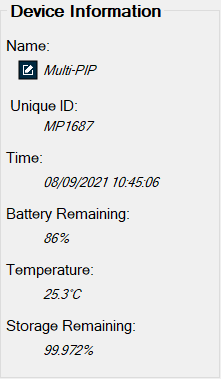
|
Information Field |
Description |
|
Name |
Configurable name given to a specific device |
|
Unique ID |
Manufacturer assigned serial number for the device |
|
Time |
Current time as read by the device |
|
Battery Remaining |
Estimation of the current battery percentage |
|
Temperature |
Internal temperature of the device |
|
Storage Remaining |
Space remaining on the device for storing measurement data |
The configuration tab is where the user can set up the parameters for their data collection. The window is broken into four main sections.
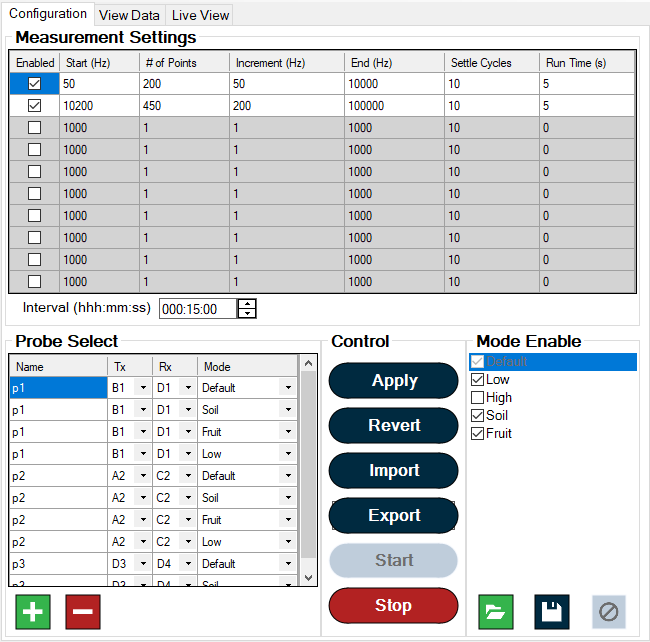
Measurement Settings
This section is where the user defines what frequencies the Multi-PIP should measure. Every probe pair specified in the probes section will take measurements based on the configuration defined in the measurements section. A measurement is defined as a single frequency sweep that is configured in this section. Each probe pair can have multiple measurements defined as needed for a specific application. The table below describes the function of each of the measurement panel entries.
Info:
Once all changes have been made to setup an experiment the user must click the apply settings button to apply the desired configuration to the connected Multi-PIP
|
Field |
Description |
Notes |
|
Enabled |
If checked, the set of frequencies specified by this row will be measured for all selected probes |
Enabling more than one row allows for specifying different densities of frequencies piecewise across multiple ranges. Unchecked lines are saved for future user use. |
|
Start (Hz) |
The start frequency for a specific frequency sweep |
User defined |
|
# of Points |
The number of points to be taken for this frequency sweep. |
User defined |
|
Increment (Hz) |
The discreet change in frequency between each individual point in this sweep |
user defined |
|
End (Hz) |
The last (highest) frequency that will be measured by the sweep |
Calculated from start frequency, number of points, and frequency increment |
|
Settle Cycles |
Time to wait between producing the stimulus signal and attempting to read the return signal |
Increasing this value can sometimes improve measurement accuracy especially at low frequencies as the cost of measurement run time and battery life |
|
Run Time (s) |
Estimated time that this frequency sweep will take to run |
Calculated from the frequencies of interest, settle time, and number of measurement points |
|
Interval (hhh:mm:ss) |
Time to wait (hours:minutes:seconds) between measuring all specified frequencies for all specified probes. |
|
Probe Select
The probes section allows the user to define which pairs to measure at each scheduled interval. The user specifies the outgoing (TX) signal and the incoming signal (RX) path to two of the front panel connectors.
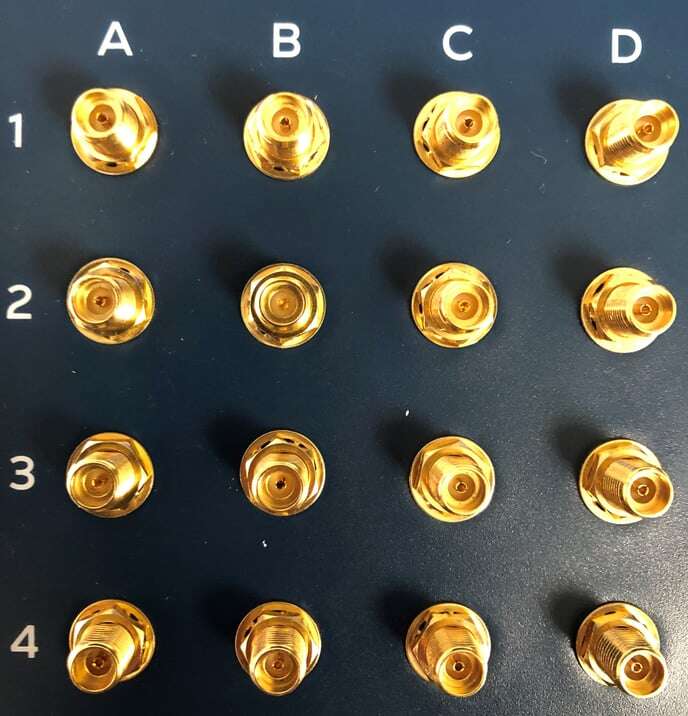
The probe is specified by the combination of its column A-D and its row 1-4 This configuration will map which connectors are associated with specific probes on the plant or in the soil. The user can also give each probe pair a name for easy tracking and identification of each measurement.
Each defined probe pair is also assigned a device mode. The selected mode will impact the range of load impedances and frequencies over which the Multi-PIP will be able to acquire accurate data. The same probe pair may be measured using multiple modes, though distinct probes must be added as in the example below.
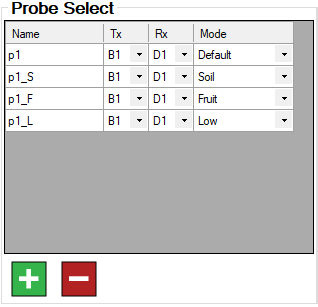
Mode Enable
This section allows for addition, removal, and enabling of up to four device modes (including the default mode). All modes present on the device will show in this list, and the checkbox next to each mode indicates whether it is enabled for use in a measurement.
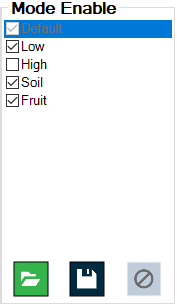
|
Button |
Name |
Description |
|
Load |
Loads a Multi-PIP mode from *.csv file. |
|
|
|
Save |
Exports a Multi-PIP mode file as a *.csv |
|
|
Delete |
Permanently deletes a Multi-PIP mode file from the device memory. Note, this button disabled with the default mode. |
Once a mode is enabled, the ‘Mode’ drop down in the ‘Probe Select’ section will include the enabled mode names. This way, the same probe pair may be measured in multiple different modes.
Control
|
Button |
Description |
|
Apply |
Applies the settings specified in the Configuration tab to the device |
|
Revert |
Reverts the settings in the Configuration tab to the ones last applied to the device |
|
Import |
Imports a saved device configuration from a file on your filesystem (*.mpcfg extension) |
|
Export |
Exports the device configuration to a file on your filesystem. Note: settings in the Configuration tab must be applied before they can be exported |
|
Start |
Starts the device taking data based on the specified device configuration settings. Note: settings in the Configuration tab must be applied before measurements can begin |
|
Stop |
Stops the device from taking data if it is currently set to do so |
The view data tab allows the user to pull data from the connected Multi-PIP device for visualization within the software, or export to .csv files for detailed analysis. The plot will update based on user input from the configuration parameters. The table below describes the functions of the different elements on the view data tab.
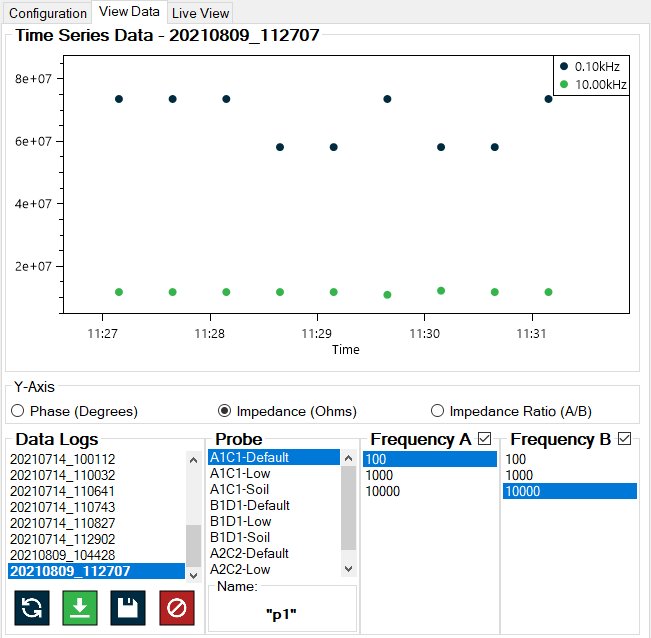
This is a list of all data logs stored on the device. A new data log is created each time the “Start” button in the Configuration tab is clicked. Each data log is named with a “YYYYMMDD_HHMMSS” timestamp which corresponds to when that log was created. The data plot can be zoomed and panned using the mouse
|
Button |
Name |
Description |
|
|
Sync |
Re-Syncs the Data Logs list from the connected Multi-PIP |
|
|
Download |
Downloads and plots the currently highlighted data log in the list from the connected device. Can take several minutes for large datasets. The data log currently downloaded is bolded in the list |
|
|
Save |
Exports a data log as a *.csv file after it has been downloaded |
|
|
Delete |
Permanently deletes a data log from the device after it has been downloaded. Cannot be undone |
Y-Axis
Selects what data to plot versus time for the currently downloaded data log. Can plot the impedance magnitude in ohms, the ratio of the impedance of frequency A to frequency B, or the impedance phase angle in degrees
Probe
Selects which probe’s data to plot in the currently downloaded data log. Also shows the name assigned to the selected pair in the Configuration tab. If different modes were used in measurements, the probe pair is hyphenated with the mode name.
Frequency A & B
Selects which two frequencies from the dataset to plot. Checkboxes allow one or both selected frequency data to be plotted in the Impedance or Phase plots.
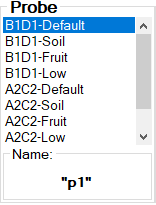
The Live View tab allows the user to take and view data on a single probe pair in real time. None of the data taken on this screen is logged, and it cannot be used if the device is currently taking scheduled measurements. This tab is primarily useful for establishing physical continuity of probes as they are being attached to a plant.
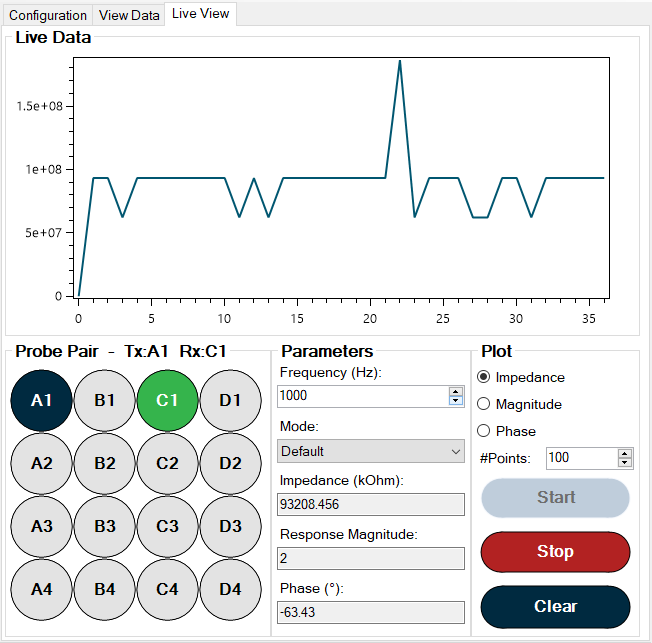
Live Data
Displays data taken in a strip chart. Can view any of the three returned parameters
Probe Pair
Control to allow the user to select which probe pair to measure. Can be changed in real time, and can switch transmit vs receive channel by clicking a probe that has already been selected.
Parameters
Displays the instantaneous values of the measured parameters. Also allows the user to adjust the output frequency being measured as well as the device mode.
Plot
Contains controls which change the number of points to show on the strip chart and which of the measured parameters to plot. Buttons will start and stop measurement, and clear the plot area.
Some auxiliary functions are made available through the application toolstrip. Below is a table describing the functionality of each tool strip menu item.
|
File |
Export -> Event Logs |
Exports all data logs stored on the Multi-PIP as .csv files for post processing to a selected folder on the user’s filesystem. |
|
File |
Export -> All Measurement Data |
Exports the connected Multi-PIP’s internal event log to a selected folder. |
|
File |
Exit |
Exits the application. |
|
Device |
Flash Firmware |
Forces a firmware update on the connected device. Note, if the device firmware does not match the software version, a firmware update will be required upon connecting to the device. |
|
Device |
Reboot |
Reboots the device selected in the Connection list. |
|
Device |
Factory Reset |
Resets all device configurations to the factory defaults. |
|
Help |
Application Logs |
Opens the folder on your filesystem which stores the application event logs. |
|
Help |
About |
Displays application information. |
The strip at the bottom of the application shows the current status of data collection that is in progress.
|
Field |
Description |
|
State |
Started - Device is waiting for the specified interval to take its next measurement Measuring… - Device is currently collecting data Stopped - Device is not taking data |
|
Last |
The last time the device took a full dataset |
|
Next |
The next time the device is scheduled to take a full dataset, based on the configured measurement interval |
|
Count |
Total number of full datasets taken since the device last started taking data |
The Multi-PIP device is designed to be durable and water resistant. When not connected to a PC the manufacturers serial number can be located on the back of the device.
Keypad
The keypad on the Multi-PIP is designed for directional navigation through the display menus, forward/backward navigation, and enabling and disabling the device’s ultra low-power mode. The front panel buttons only provide navigation when not connected to a PC, but the power button will still turn the Multi-PIP display on and off.
|
Button |
Action |
|
Up Arrow |
Navigates up when available |
|
Down Arrow |
Navigates down when available |
|
Left Arrow |
Navigates left when available |
|
Right Arrow |
Navigates right when available |
|
Center select Button |
Enters the currently selected menu option when available |
|
Back Button |
Returns to the previous menu |
|
Power Button |
Toggles the ultra low-power mode on and off. Can be held down to cancel measurements in progress. |
Display
The following options are displayed by default when the Multi-PIP wakes from ultra low-power mode and can be accessed using the navigation buttons on the front panel.
| Status | Temperature | The internal temperature of the device |
| Battery | The estimated battery percentage of the device and whether or not it is currently charging (indicated by a lightning bolt icon) | |
| Last | Timestamp for the last single dataset taken by the device | |
| Next | Timestamp for the next scheduled dataset to be taken by the device | |
| Count | Number of datasets taken since the device began taking scheduled data | |
| Logging | Start | Starts the device taking data at scheduled intervals based on the configuration set in the PC application, and creates a new data log |
| Stop | Stops the device from taking any more scheduled datasets | |
| Live Measure | Probe Pair | You can select the probe pair by using the center star button from the live measure page which will bring up the probe configuration window. In this window you can use the up/down arrows and the select button to choose the probe pairs of interest. |
| Frequency | Using the left and right arrows the user can select the stimulus frequency of the live measurement. The user can cycle between 100 Hz, 1 kHz, 10 kHz, and 100 kHz. | |
| Response | Shows the impedance in ohms and the phase angle in degrees of the selected probe pair and frequency | |
| View Settings | Device Info | Using the center star button will display a submenu showing the unique device ID as well as the user assigned device name |
| Probe Pairs | Using the left and right arrows, each probe pair configured to be measured from the PC software (and its corresponding user-assigned name) can be scrolled through and viewed | |
| Date/Time | Shows the current date and time tracked by the device. |
Regulatory Information
FCC Compliance Statement
CAUTION: The manufacturer is not responsible for any changes or modifications not expressly approved by the party responsible for compliance. Such modifications could void the user’s authority to operate the equipment.
NOTE: This equipment has been tested and found to comply with the limits for a Class A digital device, pursuant to part 15 of the FCC Rules. These limits are designed to provide reasonable protection against harmful interference when the equipment is operated in a commercial environment. This equipment generates, uses, and can radiate radio frequency energy and, if not installed and used in accordance with the instruction manual, may cause harmful interference to radio communications. Operation of this equipment in a residential area is likely to cause harmful interference in which case the user will be required to correct the interference at his own expense.
ISED Compliance Statement
This Class A digital apparatus complies with Canadian ICES-003.
Cet appareil numérique de la classe [A] est conforme à la norme NMB-003 du Canada.
CAN ICES-3 (A)/NMB-3(A)
Supplier's Declaration of Conformity
47 CFR § 2.1077 Compliance Information
Product Name: MultiPIP
Product Model: GV-MPIP-001
Manufacturer:
Growvera Inc
317 Commercial St NE Ste G1
Albuquerque, NM 87102
support@growvera.com
http://www.growvera.com
This device complies with part 15 of the FCC Rules. Operation is subject to the following two
conditions: (1) This device may not cause harmful interference, and (2) this device must accept
any interference received, including interference that may cause undesired operation.
Regulatory Contact
For more information regarding the Multi-PIP’s regulatory compliance, please email support@growvera.com


